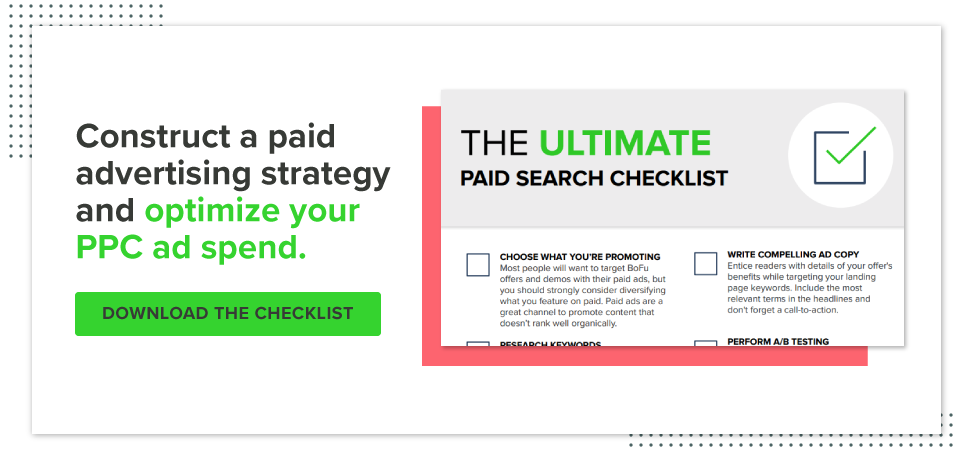4 Common PPC Advertising Strategies

When trying to attract qualified traffic to your website, there are multiple approaches a company can take. You can focus on a long-term SEO strategy to generate organic traffic. You can invest in paid ads to see immediate results. Or, you can do a combination of the two.
One major benefit of pay-per-click (PPC) advertising over organic SEO tactics is that PPC gives you more control over the search queries you appear for and the audiences you reach.
“PPC offers a media channel to capitalize on search demand,” says Senior Search Strategist Nick Basham. “It’s kind of like a digital version of the yellow pages. People are out there searching for these terms. PPC advertising allows you to show ads to people that are already looking for the things you offer, and it allows you to tailor your messaging to them.”
Here are four PPC strategies you can use to bring high-quality visitors to your website:
Branded Campaigns
Branded campaigns are a type of paid search ad that target branded terms, like your company name or trademarked terms. For example, a branded campaign for New Breed would bid on the keywords “New Breed” and “New Breed Marketing.”
“Branded campaigns are easily one of the best PPC strategies to start with,” Nick says. “They’re definitely a building block or foundational piece of your PPC strategy, no matter the industry. They’re a really good way of ensuring that you are capturing all the demand in the market for your branded terms.”
Ideally, you should already be ranking well for these keywords organically, but by putting some paid efforts into them as well, you can ensure you have the strongest possible presence in the SERPS.
“Being able to show an ad above the organic listings and take up all the real estate that’s available there through tailoring the ad copy, utilizing the 90 characters that are allowed to you via the three headlines and then the 180 characters that are allowed to you through the descriptions, that takes up a lot of space and allows you to tailor your messaging which is really important to branding,” Nick says.
The downside of branded campaigns is that you may end up paying for traffic you would have received anyways organically because if a searcher is looking for your branded terms they probably have some intent to engage with your content already.
However, research from Google has found that 89% of search ad traffic is incremental and would not be replaced by organic clicks if those ads aren’t being run. With branded terms also generally having a low cost per click, the potential rewards outweigh the risks for these types of campaigns.
Solutions Campaigns
Solutions campaigns are paid search ads focused around the specific solutions you offer in the market.
“They’re often strategically built around pain points that people may be trying to solve for,” Nick says.
So the ads themselves direct audiences to information about the products or services your company sells, but they may use language and terminology from your customer’s perspective.
For example, if a quality management software is targeting call center managers who are having trouble tracking agent performance, they might bid for the terms “call center software” or “call center management solution” as opposed to “quality management software.”
By targeting topics related to the pain points prospects have and the solutions they’re looking for, you can reach consideration stage buyers.
“These campaigns allow you to serve an ad that’s generated toward converting for someone who has a high propensity to purchase and is looking for the solution to fix their problem,” Nick says.
Retargeting Campaigns
Retargeting campaigns can include both search and display ads. They target audiences who have visited your website or engaged with your brand in an effort to get them to return and progress further in the buyer’s journey.
“I always think of paid search and retargeting as a one-two punch,” Nick says. “You’re serving an ad through Google search results with paid search, somebody spends time on your website on a specific page and then you’re able to cookie that user and follow them through their journey on the internet, keeping your product and brand top of mind and offering that extra chance to convert.”
Depending on the content you’re offering and the audience you’re targeting, retargeting ads will vary. For example, a top-of-the-funnel campaign might focus on trying to get website visitors to convert on a downloadable content offer related to the pages they were browsing. A bottom-of-the-funnel campaign might target visitors who visited specific product or service pages and try to get them to sign up for a demo.
With retargeting campaigns, it is important to set your frequency levels and targeting duration correctly so that you don’t overwhelm a prospect with your ads or spend too much time serving ads to someone who will never convert. You also stay up to date about the privacy laws governing cookies.
Conquest Campaigns
Conquest campaigns are search ads that target the branded terms of your competitors in an effort to divert traffic away from their websites and to your own.
“A conquest campaign is more of an advanced paid strategy,” Nick says. “It’s designed to drive incremental traffic to your website from people who may already be loyal to another brand.”
For example, in the image above SEMrush and Conductor both are running quest campaigns around Moz’s name.
These campaigns can be very expensive because you’re targeting branded campaigns for another company. Additionally, they tend to have lower conversion rates than other PPC campaigns because you are trying to win over prospects who have a different search intent.
“You know that person's looking for a specific brand,” Nick says. “If you’re showing them your advertisement, they may be interested, they may take a look, but based on where they are in the buyer’s journey, their brand loyalty, it may be a harder sell.”
But, if you already have a strong paid advertising strategy spanning across the other campaign types, conquest campaigns enable you to extend your reach to audiences who might not have found you otherwise and go head-to-head with competitors.
The Takeaway
As you’re running these campaigns, it’s important to regularly analyze the traffic that’s being generated and how they’re behaving once they’re on your website.
Are your ads attracting the right type of traffic to your website? Are the right ads reaching the right audiences? What are visitors from paid doing on the pages your ads lead them to? Do you have a healthy conversion rate? Are you seeing ROI?
“A big piece of a successful paid strategy is making sure that the kind of traffic you’re generating is relevant and is of high-quality,” Nick says. “Pay attention to the queries that are matching to your keyword strategy and then implement any necessary steps to remediate any irrelevant traffic through a negative keyword strategy.”
PPC campaigns will require some trial and error. But, over time as you continue to optimize your ads based on what you’ve learned from analytics, you’ll be able to efficiently generate more and more high-quality leads and customers.
Quinn Kanner
Quinn is a writer and copyeditor whose work ranges from journalism to travel writing to inbound marketing content.





